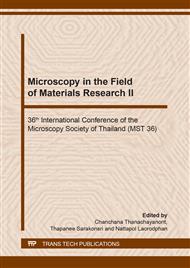[1]
A. Qurashi, K.S. Subrahmanyam, P. Kumar, Nanofiller graphene-ZnO hybrid nanoarchitecture: optical, electrical and optoelectronic investigation, J. Mater. Chem. C 3 (2015) 11959-11964.
DOI: 10.1039/c5tc02729b
Google Scholar
[2]
I. Khan, A.A.M. Ibrahim, M. Sohail, A. Qurashi, Sonochemical assisted synthesis of RGO/ZnO nanowire arrays for photoelectrochemical water splitting, Ultrason. Sonochem. 37 (2017) 669-675.
DOI: 10.1016/j.ultsonch.2017.02.029
Google Scholar
[3]
R. Kumar, O.A. Dossary, G. Kumar, A. Umar, Zinc oxide nanostructures for NO2 gas-sensor applications: A review, Nano-Micro Lett. 7 (2015) 97-120.
DOI: 10.1007/s40820-014-0023-3
Google Scholar
[4]
S.G. Leonardi, Two-dimensional zinc oxide nanostructures for gas sensor applications, Chemosensor 5 (2017) 1-28.
Google Scholar
[5]
Y.M. Manawi, K. Ibrahim, A. Samara, T.A. Ansari, M.A. Atieh, A review of carbon nanomaterials synthesis via the chemical vapor deposition (CVD) method, Materials 11 (2018) 1-36.
DOI: 10.3390/ma11050822
Google Scholar
[6]
Q. Huang, D. Zeng, H. Li, C. Xie, Room temperature formaldehyde sensors with enhanced performance, fast response and recovery based on zinc oxide quantum dots/graphene nanocomposites, Nanoscale 4 (2012) 5651-5658.
DOI: 10.1039/c2nr31131c
Google Scholar
[7]
G. Singh, A. Choudhary, D. Haranath, A.G. Joshi, N. Singh, S. Singh, R. Pasricha, ZnO decorated luminescent graphene as a potential gas sensor at room temperature, Carbon 50 (2012) 385-394.
DOI: 10.1016/j.carbon.2011.08.050
Google Scholar
[8]
R.J. Oweis, B.A. Albiss, M.I.A. Widyan, M.A.A. Akhras, Hybrid zinc oxide nanorods/carbon nanotubes composite for nitrogen dioxide gas sensing, J. Elec. Mater. 43 (2014) 3222-3228.
DOI: 10.1007/s11664-014-3274-3
Google Scholar
[9]
J. Liu, S. Li, B. Zhang, Y. Xiao, Y. Gao, Q. Yang, Y. Wang, G. Lu, Ultrasensitive and low detection limit of nitrogen dioxide gas sensor based on flower-like ZnO hierarchical nanostructure modified by reduced graphene oxide, Sens. & Actua. B 249 (2017) 715-724.
DOI: 10.1016/j.snb.2017.04.190
Google Scholar
[10]
M. Haneef, H. Saleem, A. Habib, Use of graphene nanosheets and barium titanate as fillers in PMMA for dielectric applications, Synth. Met. 223 (2017) 101-106.
DOI: 10.1016/j.synthmet.2016.12.006
Google Scholar
[11]
H. Saleem, M. Haneef, H.Y. Abbasi, Synthesis route of reduced graphene oxide via thermal reduction of chemically exfoliated graphene oxide, Mater. Chem. Phys. 204 (2018) 1-7.
DOI: 10.1016/j.matchemphys.2017.10.020
Google Scholar
[12]
C. Thomsen, S. Reich, Double resonant Raman scattering in graphite, Phys. Rev. Lett. 85 (2000) 5214-5217.
DOI: 10.1103/physrevlett.85.5214
Google Scholar
[13]
T. Chobsilp, W. Muangrat, C. Issro, W. Chaiwut, A. Eiad-ua, K. Suttiponparnit, W. Wongwiriyapan, T. Charinpanitkul, Sensitivity enhancement of benzene sensor using ethyl cellulose-coated surface-functionalized carbon nanotubes, J. Sensors 2018 (2018) 1-9.
DOI: 10.1155/2018/6956973
Google Scholar
[14]
M. Farahmandjou, S. Jurablu, Co-precipitation synthesis of zinc oxide (ZnO) nanoparticles by zinc nitrate precursor, Int. J. Bio-Inorg. Hybr. Nanomater. 3 (2014) 179-184.
Google Scholar
[15]
H. Liu, L. Shi, D. Li, J. Yu, H.M. Zhang, S. Ullah, B. Yang, C. Li, C. Zhu, J. Xu, Rational design of hierarchiral ZnO carbon nanoflower for high performance lithium ion battery anodes, J. Power Sources 387 (2018) 64-71.
DOI: 10.1016/j.jpowsour.2018.03.047
Google Scholar
[16]
S. Agnihotri, G. Bajaj, S. Mukherji, S. Mukherji, Arginine-assisted immobilization of silver nanoparticles on ZnO nanorods: an enhanced and reusable antibacterial substance without human cell cytotoxicity, Nanoscale 7 (2015) 7415-7429.
DOI: 10.1039/c4nr06913g
Google Scholar
[17]
S. Liu, B. Yu, H. Zhang, T. Fei, T. Zhang, Enhancing NO2 gas sensing performance at room temperature based on reduced graphene oxide-ZnO nanoparticles hybrids, Sens. & Actua. B 202 (2014) 272-278.
DOI: 10.1016/j.snb.2014.05.086
Google Scholar
[18]
Y.J. Kwon, A. Mirzaei, S.Y. Kang, M.S. Choi, J.H. Bang, S.S. Kim, H.W. Kim, Synthesis, characterization and gas sensing properties of ZnO-decorated MWCNTs, Appl. Sur. Sci. 413 (2017) 242-252.
DOI: 10.1016/j.apsusc.2017.03.290
Google Scholar
[19]
F. Schedin, A.K. Geim, S.V. Morozov, E.W. Hill, P. Blake, M.I. Katsnelson, K.S. Novoselov, Detection of individual gas molecules adsorbed on graphene, Nat. Mater. 6 (2007) 652-655.
DOI: 10.1038/nmat1967
Google Scholar
[20]
G. Lu, L.E. Ocola, J. Chen, Gas detection using low-temperature reduced graphene oxide sheets, Appl. Phys. Lett. 94 (2009) 1-3.
DOI: 10.1063/1.3086896
Google Scholar
[21]
L. Guo, Y.W. Hao, P.L. Li, J.F. Song, R.Z. Yang, Z.Y. Fu, S.Y. Xie, J. Zhao, Y.L. Zhang, Improved NO2 gas sensing properties of graphene oxide reduced by two-beam-laser interference, Sci. Rep. 8 (2019) 1-7.
DOI: 10.1038/s41598-018-23091-1
Google Scholar


